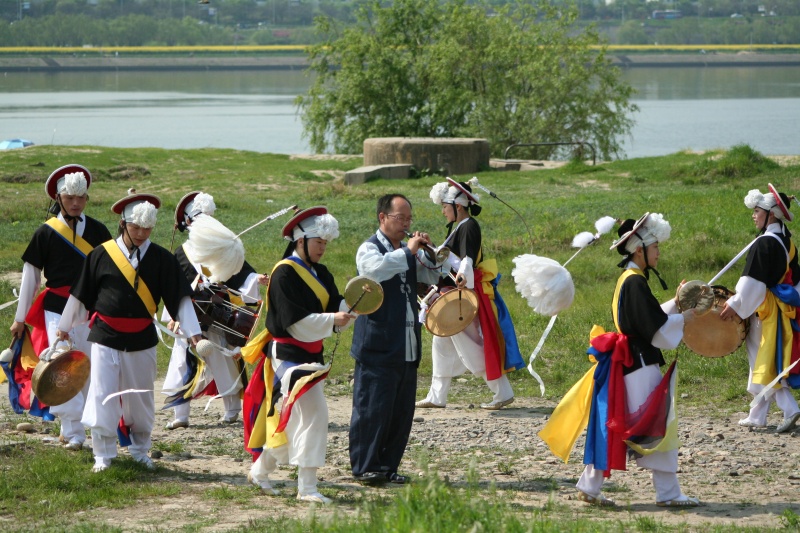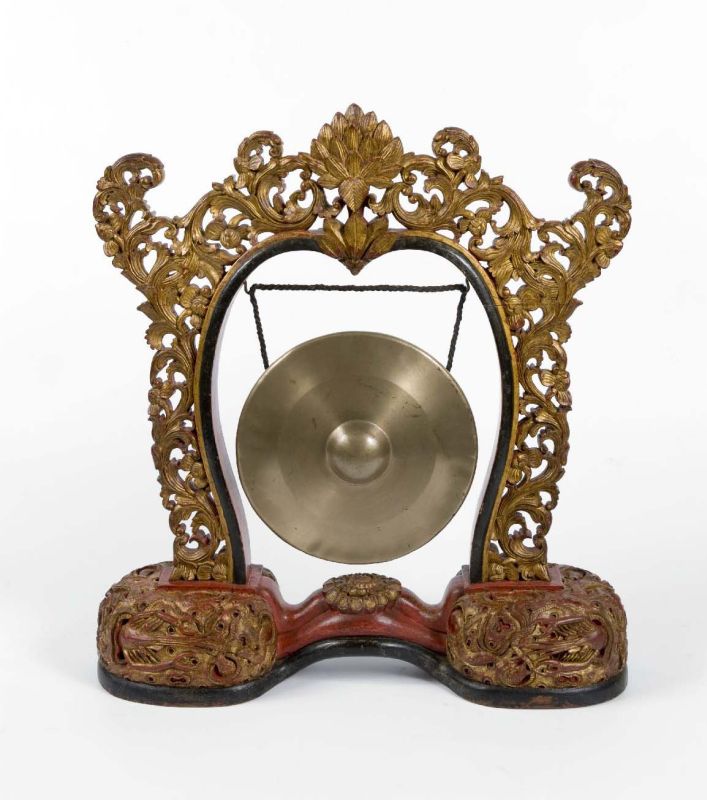|
Kwaenggwari
The ''kkwaenggwari'' (; ) is a small flat gong used in traditional Korean music. It is made of brass and is played with a hard stick. It produces a distinctively high-pitched, metallic tone that breaks into a cymbal-like crashing timbre when struck forcefully. It is particularly important in ''samul nori'' and ''pungmul'', although it is also used in other genres such as Korean shamanic music. This gong is struck with a wooden mallet to produce a sharp, attention commanding sound. The instrument is commonly used in folk performing arts in Korea, including shamanic music, dance, and mask dance drama, and is the lead instrument in pungmul. In Nongak ''Pungmul'' (; ) is a Korean folk music tradition that includes drumming, dancing, and singing. Most performances are outside, with dozens of players all in constant motion. ''Pungmul'' is rooted in the ''dure'' (collective labor) farming culture. ..., the person who beats a ''kkwaenggwari'' is called ''Sangsoe'' () or ''Busoe'' ( ... [...More Info...] [...Related Items...] OR: [Wikipedia] [Google] [Baidu] |
Samul Nori
() is a genre of Korean percussion music. It is a modern adaptation of traditional Korean musics, namely the ritual farming music '' nongak'' and Korean shamanic music ''muak'', for the indoor stage. As per its name, ''samul nori'' is performed with four traditional Korean musical instruments: a small gong ''kkwaenggwari'', the larger gong '' jing'', an hourglass-shaped drum ''janggu''; and a barrel drum called '' buk''. With dozens of professional and amateur groups, ''samul nori'' has been called "Korea’s most successful traditional music". History The term ''samul'' originally comes from Korean Buddhism, where it referred to four instruments considered essential for ritual use in temples: the wooden fish (), the temple bell (), the dharma drum (), and the bronze gong (). The term ''nori'' means "to play" in Korean. ''Samul nori'' is a modern adaptation of the traditional ritual music of Korean farmers, called '' nongak'' or ''pungmul nori'', for the stage. Traditio ... [...More Info...] [...Related Items...] OR: [Wikipedia] [Google] [Baidu] |
Pungmul
''Pungmul'' (; ) is a Traditional music of Korea#Folk music, Korean folk music tradition that includes drumming, dance, dancing, and singing. Most performances are outside, with dozens of players all in constant motion. ''Pungmul'' is rooted in the ''dure'' (collective labor) farming culture. It was originally played as part of farm work, on Culture of Korea#Festivals of the lunar calendar, rural holidays, at other village community-building events, and to accompany Korean shamanism, shamanistic rituals, mask dance dramas, and other types of performance. During the late 1960s and 1970s it expanded in meaning and was actively Pungmul as Protest, used in political protest during the pro-democracy movement, although today it is most often seen as a Performing arts, performing art. Based on 1980s research, this kind of music was extensively studied in Chindo Island. Older scholars often describe this tradition as ''nongak'' (), a term meaning "farmers' music" whose usage arose during t ... [...More Info...] [...Related Items...] OR: [Wikipedia] [Google] [Baidu] |
Traditional Music Of Korea
Korea has produced music () for thousands of years, into the modern day. After the division of Korea in 1945, both North and South Korea have produced their own styles of music. Traditional music () produced by Korea includes court music, folk music, poetic songs, and religious music used in shamanistic and Buddhist traditions. Modern music includes K-pop (), the popular music of South Korea. North Korea also produces its own popular music, as well as music that's inspired by traditional music. History Proto-Three Kingdoms of Korea Not much is known about music from the Proto-Three Kingdoms of Korea period (before 57 BCE). It is believed that Korean people practiced shamanistic rituals involving music at agricultural festivals. Tomb murals and ceramics from this period depict string instruments with complex features that suggest the instruments were quite developed. Three Kingdoms of Korea The Three Kingdoms of Korea refers to the period from 57 BCE to 668 CE when t ... [...More Info...] [...Related Items...] OR: [Wikipedia] [Google] [Baidu] |
Gong
A gongFrom Indonesian language, Indonesian and ; ; zh, c=鑼, p=luó; ; ; ; ; is a percussion instrument originating from Southeast Asia, and used widely in Southeast Asian and East Asian musical traditions. Gongs are made of metal and are circular and flat or bowl-like in shape, and can come in various sizes. They are typically struck with a mallet. They can be played alone, giving a characteristic "crashing" sound, or played as part of a tuned set that produce bell-like sounds. The earliest possible depictions of gongs is from the details on the surface of the Ngọc Lũ I Dong son drum, bronze drum () from the Dong Son culture of northern Vietnam. It depicts what looks like seven-gong ensembles along with other instruments (including cymbals/bells and the bronze drums themselves). The oldest undisputed historical mention of gongs can be found in sixth century AD Chinese records, which mentioned it as a foreign instrument that came from a country between Tibet and Bur ... [...More Info...] [...Related Items...] OR: [Wikipedia] [Google] [Baidu] |
Gong
A gongFrom Indonesian language, Indonesian and ; ; zh, c=鑼, p=luó; ; ; ; ; is a percussion instrument originating from Southeast Asia, and used widely in Southeast Asian and East Asian musical traditions. Gongs are made of metal and are circular and flat or bowl-like in shape, and can come in various sizes. They are typically struck with a mallet. They can be played alone, giving a characteristic "crashing" sound, or played as part of a tuned set that produce bell-like sounds. The earliest possible depictions of gongs is from the details on the surface of the Ngọc Lũ I Dong son drum, bronze drum () from the Dong Son culture of northern Vietnam. It depicts what looks like seven-gong ensembles along with other instruments (including cymbals/bells and the bronze drums themselves). The oldest undisputed historical mention of gongs can be found in sixth century AD Chinese records, which mentioned it as a foreign instrument that came from a country between Tibet and Bur ... [...More Info...] [...Related Items...] OR: [Wikipedia] [Google] [Baidu] |
Brass
Brass is an alloy of copper and zinc, in proportions which can be varied to achieve different colours and mechanical, electrical, acoustic and chemical properties, but copper typically has the larger proportion, generally copper and zinc. In use since prehistoric times, it is a substitutional alloy: atoms of the two constituents may replace each other within the same crystal structure. Brass is similar to bronze, a copper alloy that contains tin instead of zinc. Both bronze and brass may include small proportions of a range of other Chemical element, elements including arsenic, lead, phosphorus, aluminium, manganese and silicon. Historically, the distinction between the two alloys has been less consistent and clear, and increasingly museums use the more general term "list of copper alloys, copper alloy". Brass has long been a popular material for its bright gold-like appearance and is still used for drawer pulls and door handle, doorknobs. It has also been widely used to ma ... [...More Info...] [...Related Items...] OR: [Wikipedia] [Google] [Baidu] |
Cymbal
A cymbal is a common percussion instrument. Often used in pairs, cymbals consist of thin, normally round plates of various alloys. The majority of cymbals are of indefinite pitch, although small disc-shaped cymbals based on ancient designs sound a definite note (such as crotales). Cymbals are used in many ensembles ranging from the orchestra, percussion ensembles, jazz bands, heavy metal bands, and marching groups. Drum kits usually incorporate at least a crash, ride, or crash/ride, and a pair of hi-hat cymbals. A player of cymbals is known as a cymbalist. Etymology and names The word cymbal is derived from the Latin , which is the latinisation , which in turn derives . In orchestral scores, cymbals may be indicated by the French ; German , , , or ; Italian or ; and Spanish . Many of these derive from the word for plates. History Cymbals have existed since ancient times. Representations of cymbals may be found in reliefs and paintings from Armenian Highlands (7t ... [...More Info...] [...Related Items...] OR: [Wikipedia] [Google] [Baidu] |
Timbre
In music, timbre (), also known as tone color or tone quality (from psychoacoustics), is the perceived sound of a musical note, sound or tone. Timbre distinguishes sounds according to their source, such as choir voices and musical instruments. It also enables listeners to distinguish instruments in the same category (e.g., an oboe and a clarinet, both woodwinds). In simple terms, timbre is what makes a particular musical instrument or human voice have a different sound from another, even when they play or sing the same note. For instance, it is the difference in sound between a guitar and a piano playing the same note at the same volume. Both instruments can sound equally tuned in relation to each other as they play the same note, and while playing at the same amplitude level each instrument will still sound distinctive with its own unique tone color. Musicians distinguish instruments based on their varied timbres, even instruments playing notes at the same pitch and volume ... [...More Info...] [...Related Items...] OR: [Wikipedia] [Google] [Baidu] |
Musok Eumak
''Musok eumak'' () or ''muak'' () is the traditional Korean shamanistic music performed at and during a shamanistic ritual, the ''gut''. Music performances consist of singing, dancing, and percussion music. It is not performed solely for spiritual rites, but also allows experiencing the archetype of traditional Korean music. The music helps the shaman enter a trance, believed to enable communication with gods, ancestors, and spirits. See also * ''Samul nori () is a genre of Korean percussion music. It is a modern adaptation of traditional Korean musics, namely the ritual farming music '' nongak'' and Korean shamanic music ''muak'', for the indoor stage. As per its name, ''samul nori'' is perform ...'', a modern South Korean genre of music partially based on ''muak'' References Korean traditional music Muism {{shamanism-stub ... [...More Info...] [...Related Items...] OR: [Wikipedia] [Google] [Baidu] |







